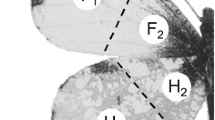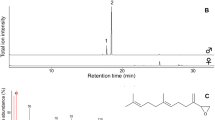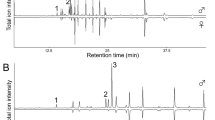Abstract
Adults of the sulfur butterfly Colias erate poliographus Motschulsky showed sexual dimorphism in their epicuticular composition, with octadecanal and hexyl myristate, palmitate, and stearate identified as male-specific compounds in 3-day-old adults. Since males of the closely related North American species Colias philodice Godart also have the 3 hexyl esters and utilize them as aphrodisiac pheromones toward conspecific females, these substances are likely to serve as pheromones for C. erate. These male-specific compounds were more abundant in wings, especially forewings, than in the body. Male wings lacked androconia but possessed characteristic intermembranous cells. These cells were present behind the base of the socket of ordinary scales and distributed from the basal to discal areas in the forewing costal region and hind wing inner-marginal region. The intermembranous cells were morphologically similar to the male-specific secretory organs of C. philodice and seemed to be the source of the male-specific compounds of C. erate. However, in the wing areas including these cells, the wing scales contained larger amounts of male-specific compounds than the wing membrane, suggesting that the male-specific compounds produced in the intermembranous cells were transferred to and disseminated from the wing scales.




Similar content being viewed by others
References
Andersson J, Borg-Karlson A-K, Wiklund C (2003) Antiaphrodisiacs in pierid butterflies: a theme with variation! J Chem Ecol 29:1489–1499
Andersson J, Borg-Karlson A-K, Vongvanich N, Wiklund C (2007) Male sex pheromone release and female mate choice in a butterfly. J Exp Biol 210:964–970
Blomquist GJ (2010) Structure and analysis of insect hydrocarbons. In: Blomquist BJ, Bagnères A-G (eds) Insect hydrocarbons: biology, biochemistry, and chemical ecology. Cambridge University Press, Cambridge, pp 19–34
Brunton CFA (1998) The evolution of ultraviolet patterns in European Colias butterflies (Lepidoptera: Pieridae): a phylogeny using mitochondrial DNA. Heredity 80:611–616
Buckner JS (1993) Cuticular polar lipids of insects. In: Stanley-Samuelson DW, Nelson DR (eds) Insect lipids: chemistry, biochemistry and biology. University of Nebraska Press, Lincoln, pp 227–270
Canavoso LE, Jouni ZE, Karnas KJ, Pennington JE, Wells MA (2001) Fat metabolism in insects. Ann Rev Nutr 21:23–46
Ginzel MD, Moreira JA, Ray AM, Millar JG, Hanks LM (2006) (Z)-9-Nonacosene—major component of the contact sex pheromone of the beetle Megacyllene caryae. J Chem Ecol 32:435–451
Grula JW, McChesney JD, Taylor OR Jr (1980) Aphrodisiac pheromones of the sulfur butterflies Colias eurytheme and C. philodice (Lepidoptera, Pieridae). J Chem Ecol 6:241–256
Guedót C, Millar JG, Horton DR, Landolt PJ (2009) Identification of a sex attractant pheromone for male winterform pear psylla, Cacopsylla pyricola. J Chem Ecol 35:1437–1447
Hall JPW, Harvey DJ (2002) A survey of androconial organs in the Riodinidae (Lepidoptera). Zool J Linn Soc 136:171–197
Juárez P, Bromquist GJ (1993) Cuticular hydrocarbons of Triatoma infestans and T. mazzotti. Comp Biochem Physiol B 106:667–674
Kristensen NP, Simonsen TJ (2003) ‘Hairs’ and cells. In: Kristensen NP, Simonsen TJ (eds) Lepidoptera, moths and butterflies vol. 2: morphology, physiology, and development. Handbuch der Zoologie/Handbook of Zoology IV/36. Walter de Gruyter, Berlin and New York, pp 9–22
Miller LD (1969) Nomenclature of wing veins and cells. J Res Lepid 8:37–48
Nieberding CM, Fischer K, Saastamoinen M, Allen CE, Wallin EA, Hedenström E, Brakefield PM (2012) Cracking the olfactory code of a butterfly: the scent of ageing. Ecol Lett 15:414–424
Ômura H, Itoh T, Wright DM, Pavulaan H, Schröder S (2015) A morphological study of alar androconia in Celastrina butterflies. Entomol Sci (in press)
Pollock DD, Watt WB, Rashbrook VK, Iyengar EV (1998) Molecular phylogeny for Colias butterflies and their relatives (Lepidoptera: Pieridae). Entomol Soc Am 91:524–531
Rutowski RL (1977) Chemical communication in the courtship of the small sulphur butterfly Eurema lisa (Lepidoptera, Pieridae). J Comp Physiol A 115:75–85
Rutowski RL (1980) Male scent-producing structures in Colias butterflies: function, localization, and adaptive features. J Chem Ecol 6:13–26
Rutowski RL, Macedonia JM, Merry JW, Morehouse NI, Yturralde K, Taylor-Taft L, Gaalema D, Kemp DJ, Papke RS (2007) Iridescent ultraviolet signal in the orange sulphur butterfly (Colias eurytheme): spatial, temporal and spectral properties. Biol J Linn Soc 90:349–364
Sappington TW, Taylor OR (1990a) Developmental and environmental sources of pheromone variation in Colias eurytheme butterflies. J Chem Ecol 16:2771–2786
Sappington TW, Taylor OR (1990b) Disruptive sexual selection in Colias eurytheme butterflies. Proc Natl Acad Sci USA 87:6132–6135
Savela M (2014) Lepidoptera and some other life forms. http://www.nic.funet.fi/pub/sci/bio/life/intro.html. Accessed 31 Oct 2014
Shimizu N, Kuwahara Y, Yakumaru R, Tanabe T (2012) n-Hexyl laurate and fourteen related fatty acid esters: new secretory compounds from the julid millipede, Anaulaciulus sp. J Chem Ecol 38:23–28
Sielberglied RE, Taylor OR (1973) Ultraviolet differences between the sulphur butterflies, Colias eurytheme and C. philodice, and a possible isolating mechanism. Nature 241:406–408
Sielberglied RE, Taylor OR Jr (1978) Ultraviolet reflection and its behavioral role in the courtship of the sulfur butterflies Colias eurytheme and C. philodice (Lepidoptera, Pieridae). Behav Ecol Sociobiol 3:203–243
Vane-Wright RI, Boppré M (1993) Visual and chemical signaling in butterflies: functional and phylogenetic perspectives. Phil Trans R Soc B 340:197–205
Vetter RS, Rutowski RL (1978) External sex brand morphology of three sulphur butterflies (Lepidoptera: Pieridae). Psyche 85:383–393
Warren BCS (1961) The androconial scales and their bearing on the question of speciation in the genus Pieris (Lepidoptera). Entomol Ts Arg 82:121–148
Wheat CW, Watt WB (2008) A mitochondrial-DNA-based phylogeny for some evolutionary-genetic model species of Colias butterflies (Lepidoptera, Pieridae). Mol Phyl Evol 47:893–902
Wheat CW, Watt WB, Boutwell CL (2005) A reconnaissance of population genetic variation in arctic and subarctic sulfur butterflies (Colias spp.; Lepidoptera, Pieridae). Can J Zool 83:1614–1623
Yildizhan S, van Loon J, Sramkova A, Ayasse M, Arsene C, ten Broeke C, Schulz S (2009) Aphrodisiac pheromones from the wings of the small cabbage white and large cabbage white butterflies, Pieris rapae and Pieris brassicae. Chem Bio Chem 10:1666–1677
Author information
Authors and Affiliations
Corresponding author
Electronic supplementary material
Below is the link to the electronic supplementary material.
Rights and permissions
About this article
Cite this article
Ômura, H., Yotsuzuka, S. Male-specific epicuticular compounds of the sulfur butterfly Colias erate poliographus (Lepidoptera: Pieridae). Appl Entomol Zool 50, 191–199 (2015). https://doi.org/10.1007/s13355-015-0321-3
Received:
Accepted:
Published:
Issue Date:
DOI: https://doi.org/10.1007/s13355-015-0321-3




